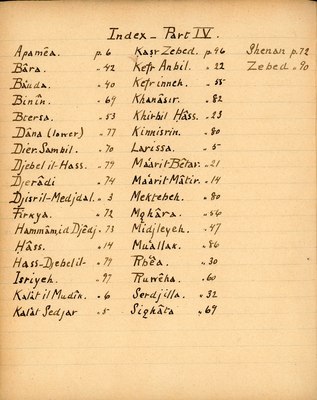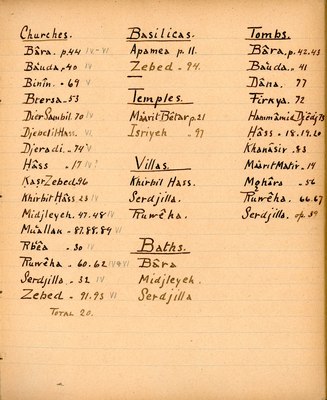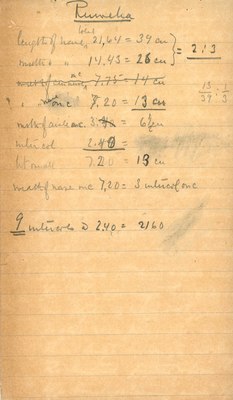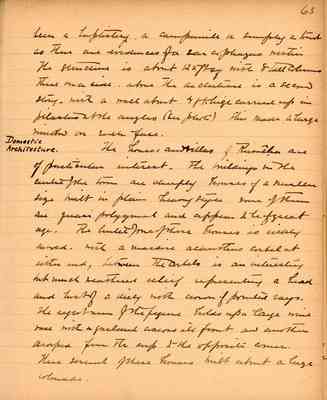Pages That Mention Ruwêḥā
Butler Diary: Northern and Central Syria IV, 1900
BSY_FB_16-01_indexa
Index - Part IV.
Apamêa p.6 Bâra p. 42 Baʿuda p. 40 Bīnîn p. 69 Btersa p. 53 Dâna (lower) p. 77 Dier Sambil p. 70 Djebel Ḥass p. 79 Djerâdi p. 74 Djisril-Medjdal p. 3 Frîkyā p. 72 Hammâmid Djêdj p. 73 Ḥâṣṣ p. 14 Hass-Djebelil p. 79 Isriyeh p. 97 Kal'at il Mudîk p. 6 Kal'at Sedjar p. 5 Ḳaṣr Zebed p. 96 Kefr Anbil p. 22 Kefrinneh p. 55 Khanâsir p. 82 Khirbil Ḥâss p. 23 Kinnisrin p. 80 Larissa p. 5 Maʿarit Bêṭar p. 21 Maʿarit Mâtir p. 14 Mektebeh p. 80 Mohâra p. 56 Midjleyeh p. 47 Muʿallak p. 86 Rbʿêa p. 30 Ruwêḥā p. 60 Serdjilla p. 32 Siqhâra p. 69 Shenan p. 72 Ḳaṣr Zebed p. 90
BSY_FB_16-01_indexb
Churches Bâra p.44 IV-VI Baʿuda p.40 IV Bīnîn p.69 V Brersa p.53 Dier Sambil p.70 IV Djebel il-Ḥâṣṣ VI Djeradi p.74 V Ḥâṣṣ p.17 IV? Ḳaṣr Zebed p.96 Khirbil Ḥâss p.23 IV Midjleyeh p.47-48 IV Muʿallak p. 87-88-89 VI Rbʿêa p.80 IV Ruwêḥā p.60-62 IV&VI Serdjilla p.32 IV Zebed p. 91-93 VI Total 20
Basilicas Apamea p.11 Zebed p.94
Temples Maàrrit Bêtar p.21 Isriyeh p.97
Villas Khirbil Hass Serdjilla Ruwêḥā
Baths Bâra Midjleyeh Serdjilla
Tombs Bâra p.42-43 Baʿuda p.41 Dâna p.77 Frîkyāp.72 Hammâmid Djêdj p.73 Ḥâṣṣ p.18-19-20 Khanâṣir p.83 Maʿarit Mâtir p.14 Mohâra p.56 Ruwêḥā p.66-67 Serdjilla p.39
BSY_FB_16-60
60
This is one of the most important ruins visited by de Vogüé - it stands quite by itself and there is no village near. A few bedouins have settled in one of the better preserved houses.
Ruwêḥā is situated on one of the lower ridges on the easternmost slopes of the [Djebel ...] (Rîhā) It looks out toward the level desert, only one ruin can be seen further to the east that is Serardi.
The ruins are notable for two well preserved churches, of quite different styles and apparently of widely separate periods, a wonderful group of private houses and several tombs of uncommon beauty - well preserved.
Churches. The North church was carefully published by de Vogüé. It is one of the largest church edifices of the region standing quite alone surrounded by a high well built wall. Within the entrance are two large tombs, one to the north and one to the south of the nave near its east end. The church differs from the ordinary church structures of the region in having but three great
BSY_FB_16-61ainsert1
length of nave ^ total ^ 21.64 = 39cu} = 2:3 width of " 14.43 = 26cu}
" " nave on. c 7.20 = 13cu 13/39 : 1/3 _____ width of aisle mc 3.XX = 6 1/2 cu inter. col. 2.40 = ______ ht. xx wall 7.20 = 13cu width of nave mc 7.20 = 3 inter col on c
9 inter cols @ 2.40 = 2160
BSY_FB_16-63
63
been a baptistry, a campanile, or simply a tomb as there are evidences of a sarcophagus within. The structure is about 12ft sq with 8 tall columns these on a side. Above the architrave is a second story with a wall about 4ft high carried up in pilasters at the angles (see photo) This made a large window on each face.
Domestic Architecture. The houses and villas of Ruwêḥā are of particular interest. The buildings in the center of the town are chiefly houses of a smaller size built in plain heavy style. Some of them are quasi polygonal and appear to be of great age. The lintel of one of these houses is richly carved with a massive acanthus corbel at either end, between the corbels is an interesting but much weathered relief representing a head and bust of a diety with crown of pointed rays. The regulum of the figure holds up a large wine vase with a garland across its front and another draped from the cap to the opposite corner. Here several of these houses built about a large colonnade.





